Qantas Airlines: Competitive Strategy, Strategic Tools, and Analysis
VerifiedAdded on 2023/06/08
|8
|1887
|111
Report
AI Summary
This report provides a comprehensive analysis of Qantas Airlines' competitive strategy, utilizing several strategic development tools. The analysis begins with an overview of Qantas, followed by a detailed SWOT analysis that identifies the airline's strengths, weaknesses, opportunities, and threats. The report then applies a PESTLE analysis to evaluate the macro-environmental factors influencing Qantas' performance, examining political, economic, social, technological, environmental, and legal factors. Furthermore, the report incorporates Porter's Five Forces framework to assess the competitive intensity within the airline industry, considering factors such as the bargaining power of consumers and suppliers, the threat of substitutes and new entrants, and the intensity of rivalry among existing competitors. Finally, the report examines Porter's generic strategies, specifically focusing on how Qantas utilizes a differentiation strategy to achieve a competitive advantage. The report concludes by summarizing the findings and emphasizing the importance of these strategic tools in supporting Qantas' competitive positioning within the market.
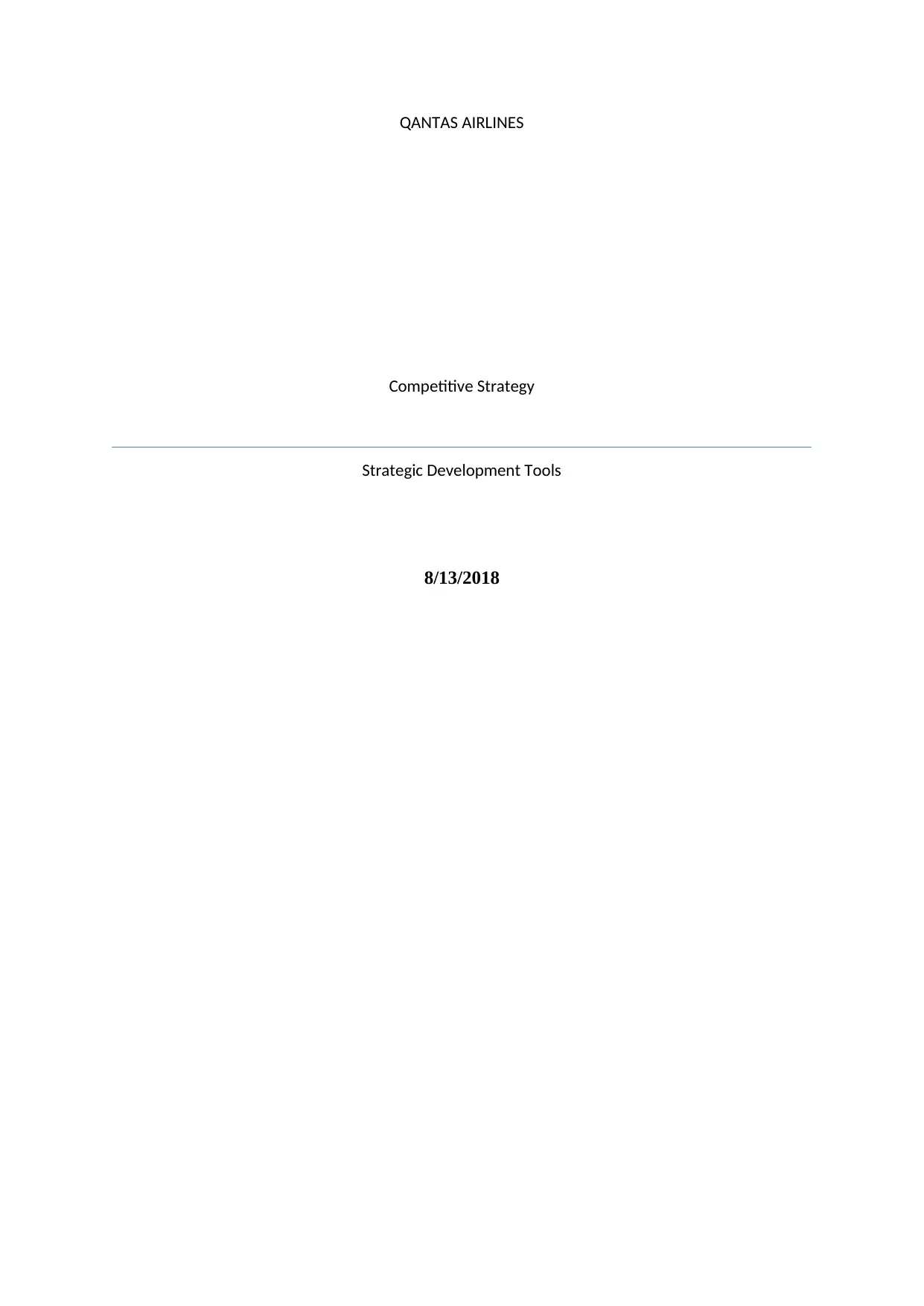
QANTAS AIRLINES
Competitive Strategy
Strategic Development Tools
8/13/2018
Competitive Strategy
Strategic Development Tools
8/13/2018
Paraphrase This Document
Need a fresh take? Get an instant paraphrase of this document with our AI Paraphraser
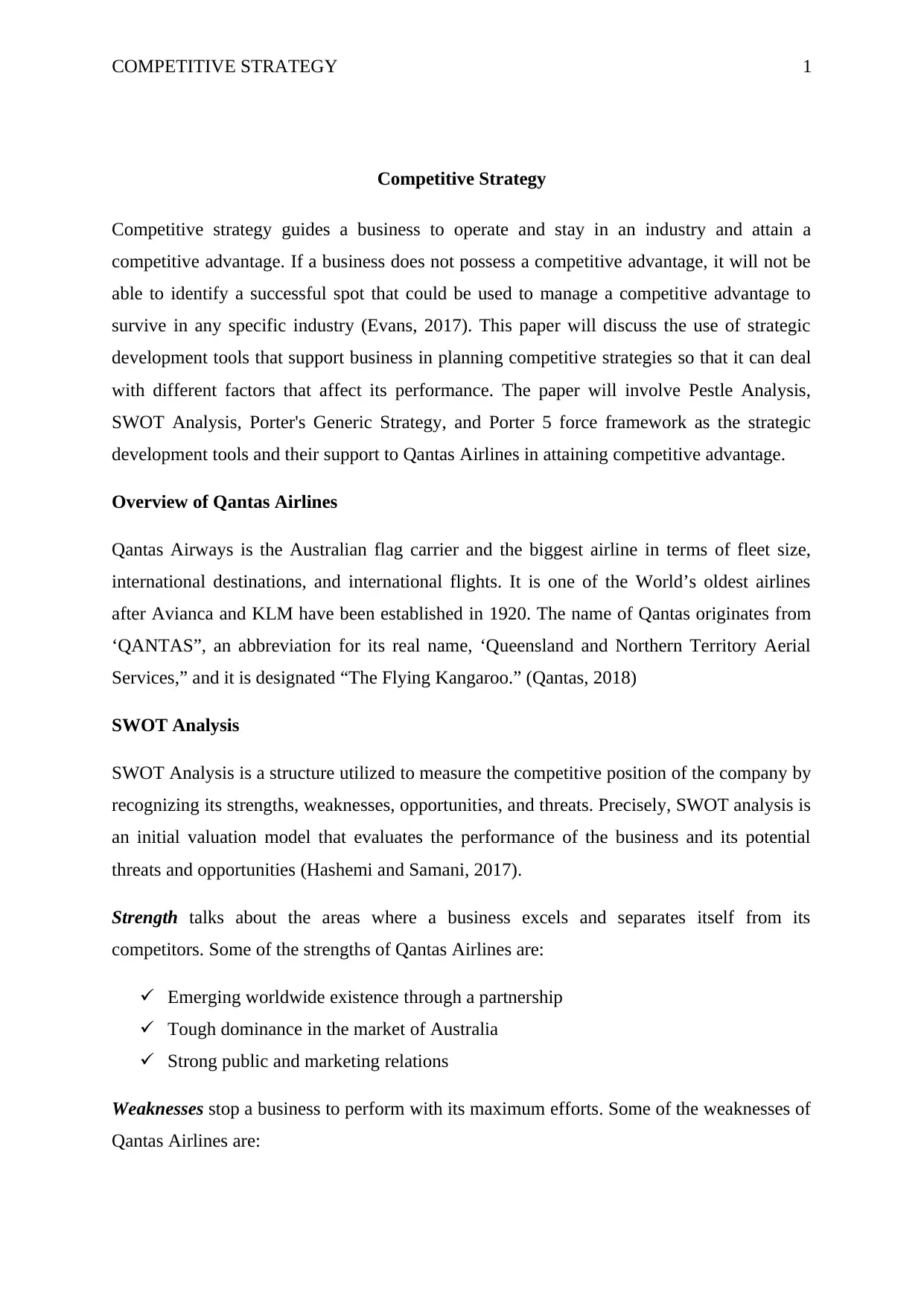
COMPETITIVE STRATEGY 1
Competitive Strategy
Competitive strategy guides a business to operate and stay in an industry and attain a
competitive advantage. If a business does not possess a competitive advantage, it will not be
able to identify a successful spot that could be used to manage a competitive advantage to
survive in any specific industry (Evans, 2017). This paper will discuss the use of strategic
development tools that support business in planning competitive strategies so that it can deal
with different factors that affect its performance. The paper will involve Pestle Analysis,
SWOT Analysis, Porter's Generic Strategy, and Porter 5 force framework as the strategic
development tools and their support to Qantas Airlines in attaining competitive advantage.
Overview of Qantas Airlines
Qantas Airways is the Australian flag carrier and the biggest airline in terms of fleet size,
international destinations, and international flights. It is one of the World’s oldest airlines
after Avianca and KLM have been established in 1920. The name of Qantas originates from
‘QANTAS”, an abbreviation for its real name, ‘Queensland and Northern Territory Aerial
Services,” and it is designated “The Flying Kangaroo.” (Qantas, 2018)
SWOT Analysis
SWOT Analysis is a structure utilized to measure the competitive position of the company by
recognizing its strengths, weaknesses, opportunities, and threats. Precisely, SWOT analysis is
an initial valuation model that evaluates the performance of the business and its potential
threats and opportunities (Hashemi and Samani, 2017).
Strength talks about the areas where a business excels and separates itself from its
competitors. Some of the strengths of Qantas Airlines are:
Emerging worldwide existence through a partnership
Tough dominance in the market of Australia
Strong public and marketing relations
Weaknesses stop a business to perform with its maximum efforts. Some of the weaknesses of
Qantas Airlines are:
Competitive Strategy
Competitive strategy guides a business to operate and stay in an industry and attain a
competitive advantage. If a business does not possess a competitive advantage, it will not be
able to identify a successful spot that could be used to manage a competitive advantage to
survive in any specific industry (Evans, 2017). This paper will discuss the use of strategic
development tools that support business in planning competitive strategies so that it can deal
with different factors that affect its performance. The paper will involve Pestle Analysis,
SWOT Analysis, Porter's Generic Strategy, and Porter 5 force framework as the strategic
development tools and their support to Qantas Airlines in attaining competitive advantage.
Overview of Qantas Airlines
Qantas Airways is the Australian flag carrier and the biggest airline in terms of fleet size,
international destinations, and international flights. It is one of the World’s oldest airlines
after Avianca and KLM have been established in 1920. The name of Qantas originates from
‘QANTAS”, an abbreviation for its real name, ‘Queensland and Northern Territory Aerial
Services,” and it is designated “The Flying Kangaroo.” (Qantas, 2018)
SWOT Analysis
SWOT Analysis is a structure utilized to measure the competitive position of the company by
recognizing its strengths, weaknesses, opportunities, and threats. Precisely, SWOT analysis is
an initial valuation model that evaluates the performance of the business and its potential
threats and opportunities (Hashemi and Samani, 2017).
Strength talks about the areas where a business excels and separates itself from its
competitors. Some of the strengths of Qantas Airlines are:
Emerging worldwide existence through a partnership
Tough dominance in the market of Australia
Strong public and marketing relations
Weaknesses stop a business to perform with its maximum efforts. Some of the weaknesses of
Qantas Airlines are:
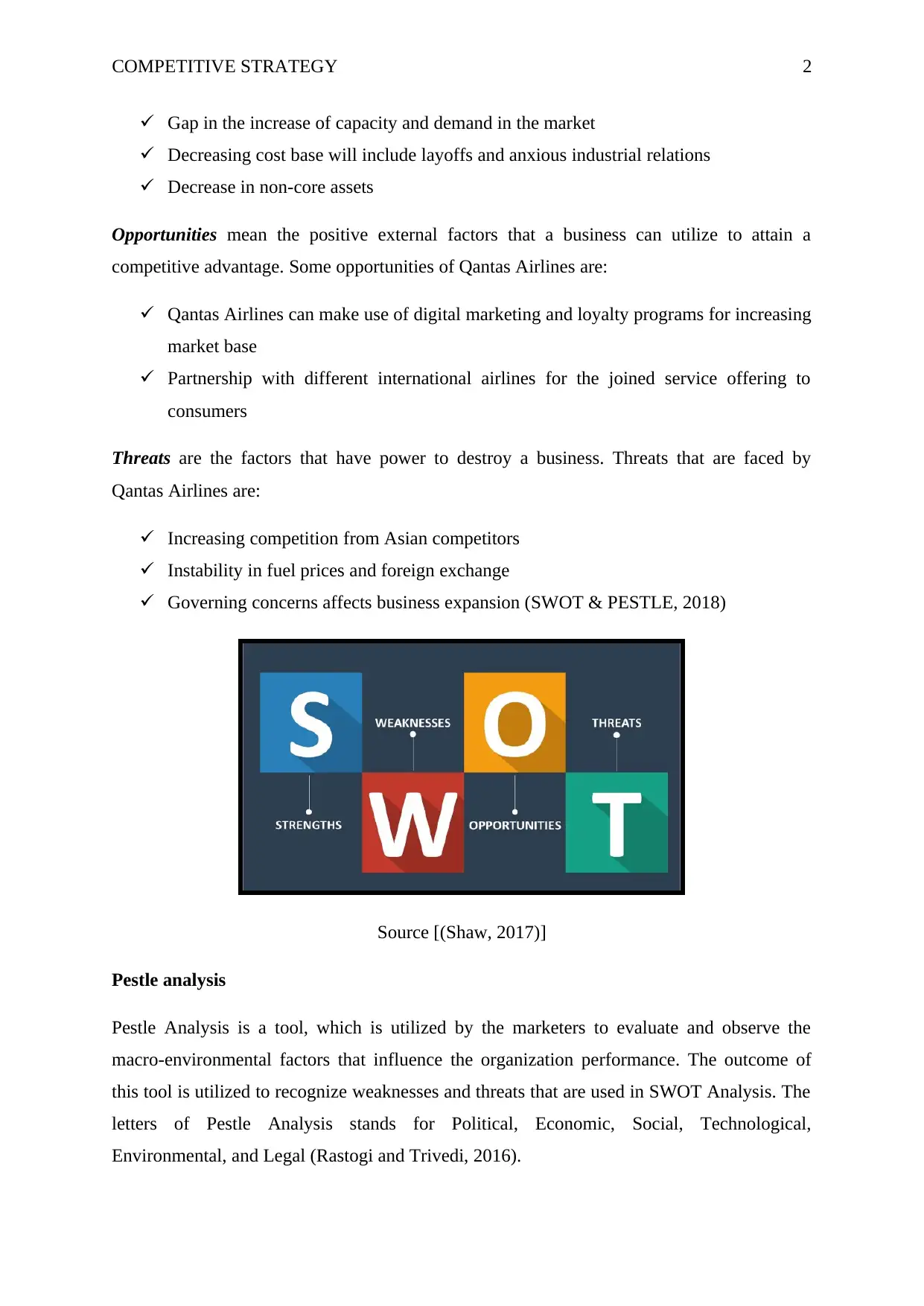
COMPETITIVE STRATEGY 2
Gap in the increase of capacity and demand in the market
Decreasing cost base will include layoffs and anxious industrial relations
Decrease in non-core assets
Opportunities mean the positive external factors that a business can utilize to attain a
competitive advantage. Some opportunities of Qantas Airlines are:
Qantas Airlines can make use of digital marketing and loyalty programs for increasing
market base
Partnership with different international airlines for the joined service offering to
consumers
Threats are the factors that have power to destroy a business. Threats that are faced by
Qantas Airlines are:
Increasing competition from Asian competitors
Instability in fuel prices and foreign exchange
Governing concerns affects business expansion (SWOT & PESTLE, 2018)
Source [(Shaw, 2017)]
Pestle analysis
Pestle Analysis is a tool, which is utilized by the marketers to evaluate and observe the
macro-environmental factors that influence the organization performance. The outcome of
this tool is utilized to recognize weaknesses and threats that are used in SWOT Analysis. The
letters of Pestle Analysis stands for Political, Economic, Social, Technological,
Environmental, and Legal (Rastogi and Trivedi, 2016).
Gap in the increase of capacity and demand in the market
Decreasing cost base will include layoffs and anxious industrial relations
Decrease in non-core assets
Opportunities mean the positive external factors that a business can utilize to attain a
competitive advantage. Some opportunities of Qantas Airlines are:
Qantas Airlines can make use of digital marketing and loyalty programs for increasing
market base
Partnership with different international airlines for the joined service offering to
consumers
Threats are the factors that have power to destroy a business. Threats that are faced by
Qantas Airlines are:
Increasing competition from Asian competitors
Instability in fuel prices and foreign exchange
Governing concerns affects business expansion (SWOT & PESTLE, 2018)
Source [(Shaw, 2017)]
Pestle analysis
Pestle Analysis is a tool, which is utilized by the marketers to evaluate and observe the
macro-environmental factors that influence the organization performance. The outcome of
this tool is utilized to recognize weaknesses and threats that are used in SWOT Analysis. The
letters of Pestle Analysis stands for Political, Economic, Social, Technological,
Environmental, and Legal (Rastogi and Trivedi, 2016).
⊘ This is a preview!⊘
Do you want full access?
Subscribe today to unlock all pages.

Trusted by 1+ million students worldwide
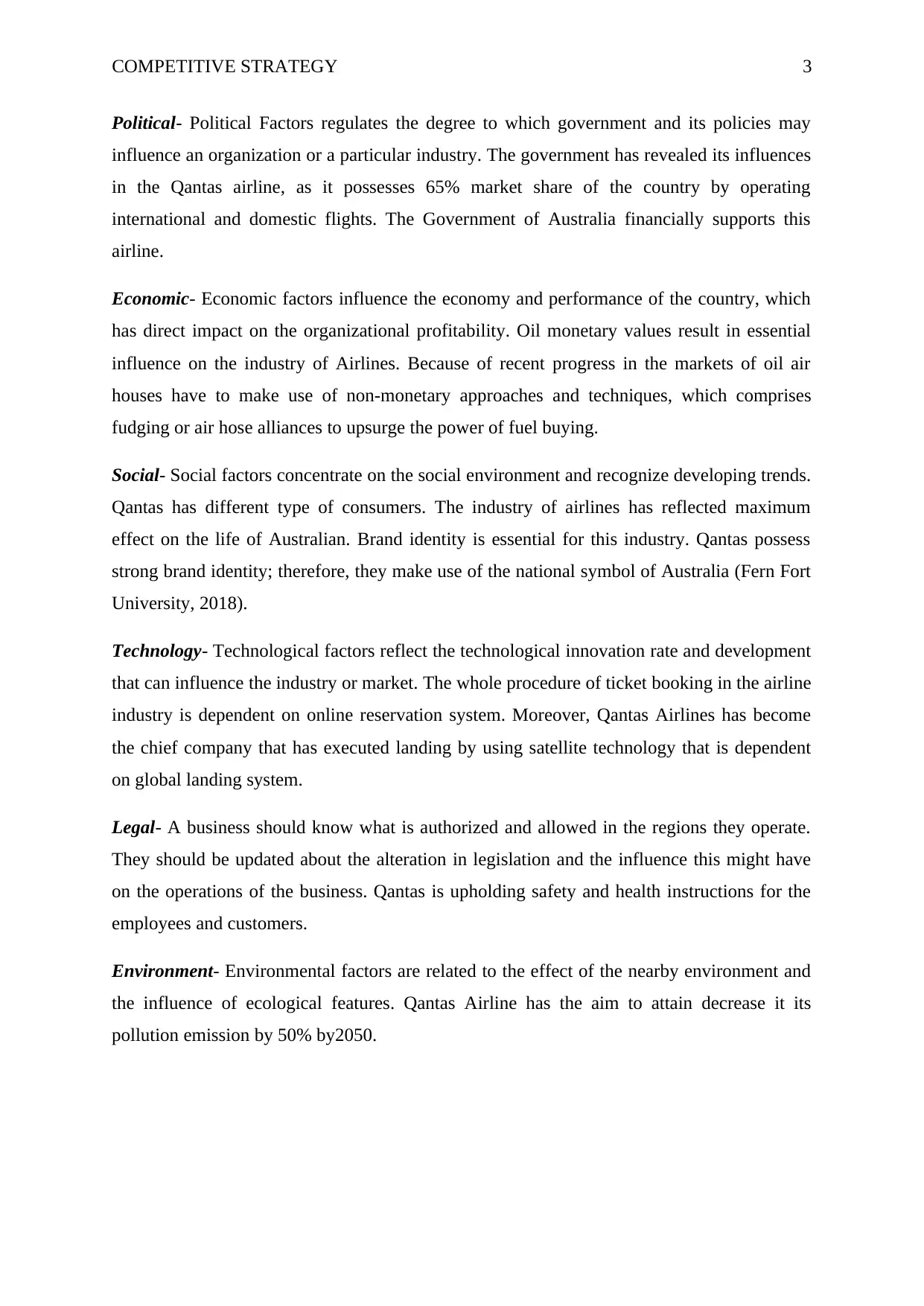
COMPETITIVE STRATEGY 3
Political- Political Factors regulates the degree to which government and its policies may
influence an organization or a particular industry. The government has revealed its influences
in the Qantas airline, as it possesses 65% market share of the country by operating
international and domestic flights. The Government of Australia financially supports this
airline.
Economic- Economic factors influence the economy and performance of the country, which
has direct impact on the organizational profitability. Oil monetary values result in essential
influence on the industry of Airlines. Because of recent progress in the markets of oil air
houses have to make use of non-monetary approaches and techniques, which comprises
fudging or air hose alliances to upsurge the power of fuel buying.
Social- Social factors concentrate on the social environment and recognize developing trends.
Qantas has different type of consumers. The industry of airlines has reflected maximum
effect on the life of Australian. Brand identity is essential for this industry. Qantas possess
strong brand identity; therefore, they make use of the national symbol of Australia (Fern Fort
University, 2018).
Technology- Technological factors reflect the technological innovation rate and development
that can influence the industry or market. The whole procedure of ticket booking in the airline
industry is dependent on online reservation system. Moreover, Qantas Airlines has become
the chief company that has executed landing by using satellite technology that is dependent
on global landing system.
Legal- A business should know what is authorized and allowed in the regions they operate.
They should be updated about the alteration in legislation and the influence this might have
on the operations of the business. Qantas is upholding safety and health instructions for the
employees and customers.
Environment- Environmental factors are related to the effect of the nearby environment and
the influence of ecological features. Qantas Airline has the aim to attain decrease it its
pollution emission by 50% by2050.
Political- Political Factors regulates the degree to which government and its policies may
influence an organization or a particular industry. The government has revealed its influences
in the Qantas airline, as it possesses 65% market share of the country by operating
international and domestic flights. The Government of Australia financially supports this
airline.
Economic- Economic factors influence the economy and performance of the country, which
has direct impact on the organizational profitability. Oil monetary values result in essential
influence on the industry of Airlines. Because of recent progress in the markets of oil air
houses have to make use of non-monetary approaches and techniques, which comprises
fudging or air hose alliances to upsurge the power of fuel buying.
Social- Social factors concentrate on the social environment and recognize developing trends.
Qantas has different type of consumers. The industry of airlines has reflected maximum
effect on the life of Australian. Brand identity is essential for this industry. Qantas possess
strong brand identity; therefore, they make use of the national symbol of Australia (Fern Fort
University, 2018).
Technology- Technological factors reflect the technological innovation rate and development
that can influence the industry or market. The whole procedure of ticket booking in the airline
industry is dependent on online reservation system. Moreover, Qantas Airlines has become
the chief company that has executed landing by using satellite technology that is dependent
on global landing system.
Legal- A business should know what is authorized and allowed in the regions they operate.
They should be updated about the alteration in legislation and the influence this might have
on the operations of the business. Qantas is upholding safety and health instructions for the
employees and customers.
Environment- Environmental factors are related to the effect of the nearby environment and
the influence of ecological features. Qantas Airline has the aim to attain decrease it its
pollution emission by 50% by2050.
Paraphrase This Document
Need a fresh take? Get an instant paraphrase of this document with our AI Paraphraser
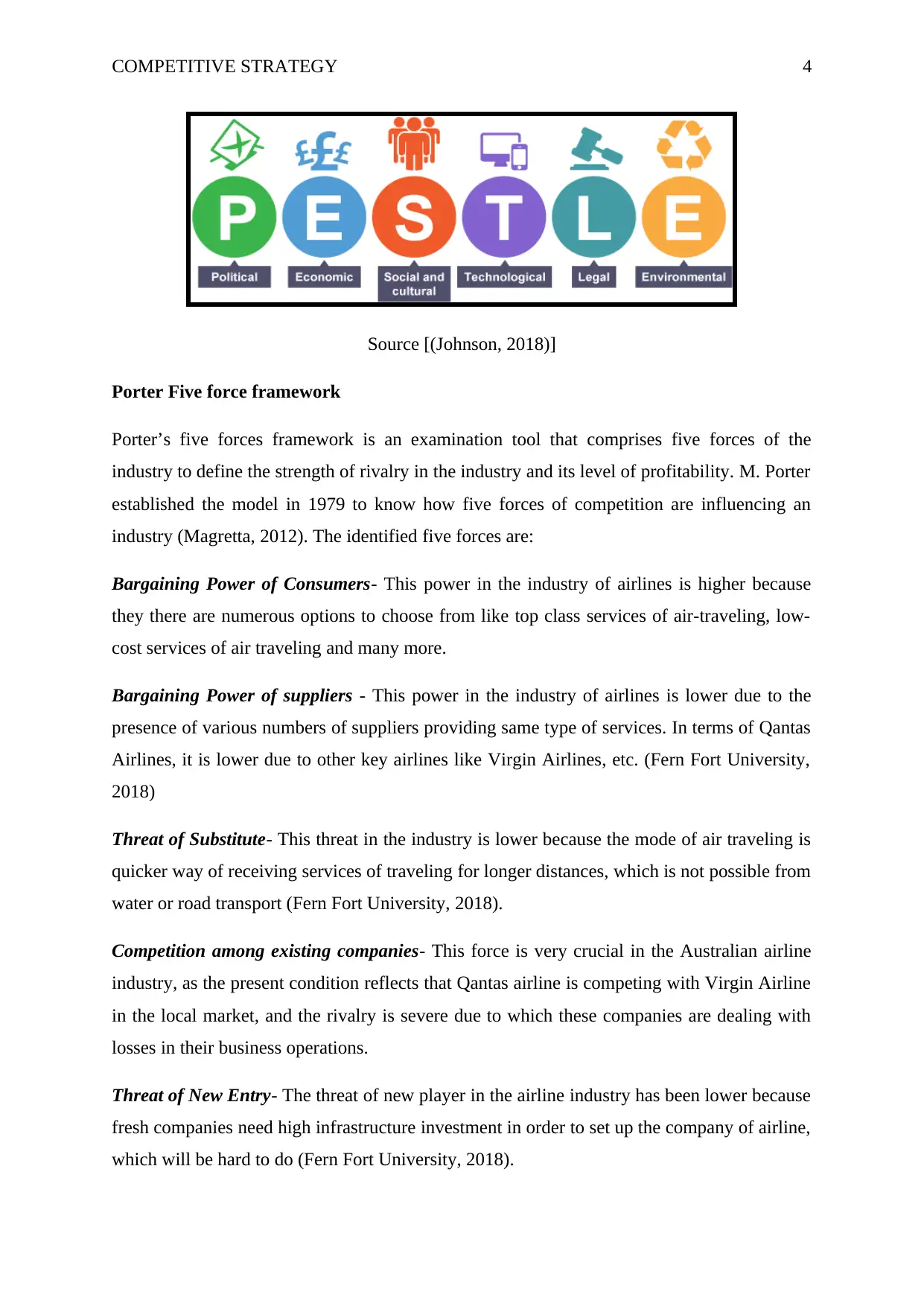
COMPETITIVE STRATEGY 4
Source [(Johnson, 2018)]
Porter Five force framework
Porter’s five forces framework is an examination tool that comprises five forces of the
industry to define the strength of rivalry in the industry and its level of profitability. M. Porter
established the model in 1979 to know how five forces of competition are influencing an
industry (Magretta, 2012). The identified five forces are:
Bargaining Power of Consumers- This power in the industry of airlines is higher because
they there are numerous options to choose from like top class services of air-traveling, low-
cost services of air traveling and many more.
Bargaining Power of suppliers - This power in the industry of airlines is lower due to the
presence of various numbers of suppliers providing same type of services. In terms of Qantas
Airlines, it is lower due to other key airlines like Virgin Airlines, etc. (Fern Fort University,
2018)
Threat of Substitute- This threat in the industry is lower because the mode of air traveling is
quicker way of receiving services of traveling for longer distances, which is not possible from
water or road transport (Fern Fort University, 2018).
Competition among existing companies- This force is very crucial in the Australian airline
industry, as the present condition reflects that Qantas airline is competing with Virgin Airline
in the local market, and the rivalry is severe due to which these companies are dealing with
losses in their business operations.
Threat of New Entry- The threat of new player in the airline industry has been lower because
fresh companies need high infrastructure investment in order to set up the company of airline,
which will be hard to do (Fern Fort University, 2018).
Source [(Johnson, 2018)]
Porter Five force framework
Porter’s five forces framework is an examination tool that comprises five forces of the
industry to define the strength of rivalry in the industry and its level of profitability. M. Porter
established the model in 1979 to know how five forces of competition are influencing an
industry (Magretta, 2012). The identified five forces are:
Bargaining Power of Consumers- This power in the industry of airlines is higher because
they there are numerous options to choose from like top class services of air-traveling, low-
cost services of air traveling and many more.
Bargaining Power of suppliers - This power in the industry of airlines is lower due to the
presence of various numbers of suppliers providing same type of services. In terms of Qantas
Airlines, it is lower due to other key airlines like Virgin Airlines, etc. (Fern Fort University,
2018)
Threat of Substitute- This threat in the industry is lower because the mode of air traveling is
quicker way of receiving services of traveling for longer distances, which is not possible from
water or road transport (Fern Fort University, 2018).
Competition among existing companies- This force is very crucial in the Australian airline
industry, as the present condition reflects that Qantas airline is competing with Virgin Airline
in the local market, and the rivalry is severe due to which these companies are dealing with
losses in their business operations.
Threat of New Entry- The threat of new player in the airline industry has been lower because
fresh companies need high infrastructure investment in order to set up the company of airline,
which will be hard to do (Fern Fort University, 2018).
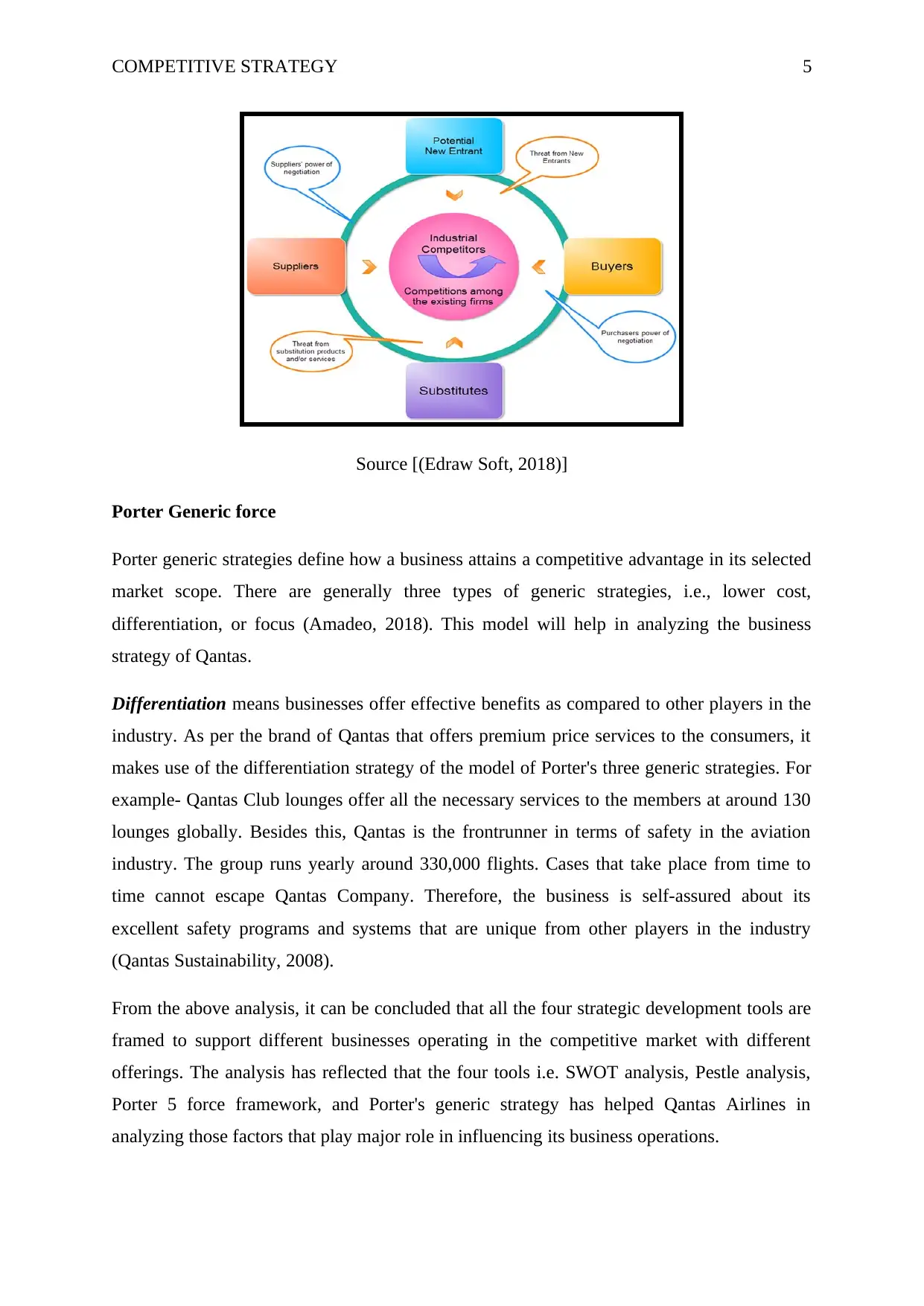
COMPETITIVE STRATEGY 5
Source [(Edraw Soft, 2018)]
Porter Generic force
Porter generic strategies define how a business attains a competitive advantage in its selected
market scope. There are generally three types of generic strategies, i.e., lower cost,
differentiation, or focus (Amadeo, 2018). This model will help in analyzing the business
strategy of Qantas.
Differentiation means businesses offer effective benefits as compared to other players in the
industry. As per the brand of Qantas that offers premium price services to the consumers, it
makes use of the differentiation strategy of the model of Porter's three generic strategies. For
example- Qantas Club lounges offer all the necessary services to the members at around 130
lounges globally. Besides this, Qantas is the frontrunner in terms of safety in the aviation
industry. The group runs yearly around 330,000 flights. Cases that take place from time to
time cannot escape Qantas Company. Therefore, the business is self-assured about its
excellent safety programs and systems that are unique from other players in the industry
(Qantas Sustainability, 2008).
From the above analysis, it can be concluded that all the four strategic development tools are
framed to support different businesses operating in the competitive market with different
offerings. The analysis has reflected that the four tools i.e. SWOT analysis, Pestle analysis,
Porter 5 force framework, and Porter's generic strategy has helped Qantas Airlines in
analyzing those factors that play major role in influencing its business operations.
Source [(Edraw Soft, 2018)]
Porter Generic force
Porter generic strategies define how a business attains a competitive advantage in its selected
market scope. There are generally three types of generic strategies, i.e., lower cost,
differentiation, or focus (Amadeo, 2018). This model will help in analyzing the business
strategy of Qantas.
Differentiation means businesses offer effective benefits as compared to other players in the
industry. As per the brand of Qantas that offers premium price services to the consumers, it
makes use of the differentiation strategy of the model of Porter's three generic strategies. For
example- Qantas Club lounges offer all the necessary services to the members at around 130
lounges globally. Besides this, Qantas is the frontrunner in terms of safety in the aviation
industry. The group runs yearly around 330,000 flights. Cases that take place from time to
time cannot escape Qantas Company. Therefore, the business is self-assured about its
excellent safety programs and systems that are unique from other players in the industry
(Qantas Sustainability, 2008).
From the above analysis, it can be concluded that all the four strategic development tools are
framed to support different businesses operating in the competitive market with different
offerings. The analysis has reflected that the four tools i.e. SWOT analysis, Pestle analysis,
Porter 5 force framework, and Porter's generic strategy has helped Qantas Airlines in
analyzing those factors that play major role in influencing its business operations.
⊘ This is a preview!⊘
Do you want full access?
Subscribe today to unlock all pages.

Trusted by 1+ million students worldwide

COMPETITIVE STRATEGY 6
References
Amadeo, K. (2018) What Is Competitive Advantage? Three Strategies That Work [online].
Available from https://www.thebalance.com/what-is-competitive-advantage-3-strategies-that-
work-3305828 [accessed 13 August 2018]
Evans, A. (2017) The Importance Of Competitive Strategy [online]. Available from
https://www.linkedin.com/pulse/importance-competitive-strategy-achara-evans [accessed 13
August 2018]
Edraw Soft (2018) Porter's Five Forces Model Templates [online]. Available from
https://www.edrawsoft.com/fiveforcesmodel.php [accessed 13 August 2018]
Fern Fort University (2018) Qantas Airways Limited PESTEL & Environment Analysis
[online]. Available from http://fernfortuniversity.com/term-papers/pestel/nyse4/6367-qantas-
airways-limited.php [accessed 13 August 2018]
Fern Fort University (2018) Qantas Airways Limited Porter Five Forces Analysis [online].
Available from http://fernfortuniversity.com/term-papers/porter5/asx/2178-qantas-airways-
limited.php [accessed 13 August 2018]
Hashemi, S.M., and Samani, F.S. (2017) Strengths, Weaknesses, Opportunities and Threats
(SWOT) Analysis and Strategic Planning for Iranian Language Institutions Development.
Journal of Applied Linguistics and Language Research, 4(2), 139-149.
Johnson, H. (2018) Pestle Analysis Small Law Firm in the UK [online]. Available from
https://solvitonline.com/pestle-analysis-sample-small-law-firm/ [accessed 13 August 2018]
Magretta, J. (2012) Understanding Michael Porter: The Essential Guide to Competition and
Strategy 2nd ed. U.S: Harvard Business Press.
Qantas (2018) Our Company [online]. Available from
https://www.qantas.com/travel/airlines/company/global/en [accessed 13 August 2018]
Qantas Sustainability (2008) Sustaining the Spirit [online]. Available from
https://www.qantas.com.au/infodetail/about/investors/sustainability2008.pdf [accessed 13
August 2018]
References
Amadeo, K. (2018) What Is Competitive Advantage? Three Strategies That Work [online].
Available from https://www.thebalance.com/what-is-competitive-advantage-3-strategies-that-
work-3305828 [accessed 13 August 2018]
Evans, A. (2017) The Importance Of Competitive Strategy [online]. Available from
https://www.linkedin.com/pulse/importance-competitive-strategy-achara-evans [accessed 13
August 2018]
Edraw Soft (2018) Porter's Five Forces Model Templates [online]. Available from
https://www.edrawsoft.com/fiveforcesmodel.php [accessed 13 August 2018]
Fern Fort University (2018) Qantas Airways Limited PESTEL & Environment Analysis
[online]. Available from http://fernfortuniversity.com/term-papers/pestel/nyse4/6367-qantas-
airways-limited.php [accessed 13 August 2018]
Fern Fort University (2018) Qantas Airways Limited Porter Five Forces Analysis [online].
Available from http://fernfortuniversity.com/term-papers/porter5/asx/2178-qantas-airways-
limited.php [accessed 13 August 2018]
Hashemi, S.M., and Samani, F.S. (2017) Strengths, Weaknesses, Opportunities and Threats
(SWOT) Analysis and Strategic Planning for Iranian Language Institutions Development.
Journal of Applied Linguistics and Language Research, 4(2), 139-149.
Johnson, H. (2018) Pestle Analysis Small Law Firm in the UK [online]. Available from
https://solvitonline.com/pestle-analysis-sample-small-law-firm/ [accessed 13 August 2018]
Magretta, J. (2012) Understanding Michael Porter: The Essential Guide to Competition and
Strategy 2nd ed. U.S: Harvard Business Press.
Qantas (2018) Our Company [online]. Available from
https://www.qantas.com/travel/airlines/company/global/en [accessed 13 August 2018]
Qantas Sustainability (2008) Sustaining the Spirit [online]. Available from
https://www.qantas.com.au/infodetail/about/investors/sustainability2008.pdf [accessed 13
August 2018]
Paraphrase This Document
Need a fresh take? Get an instant paraphrase of this document with our AI Paraphraser
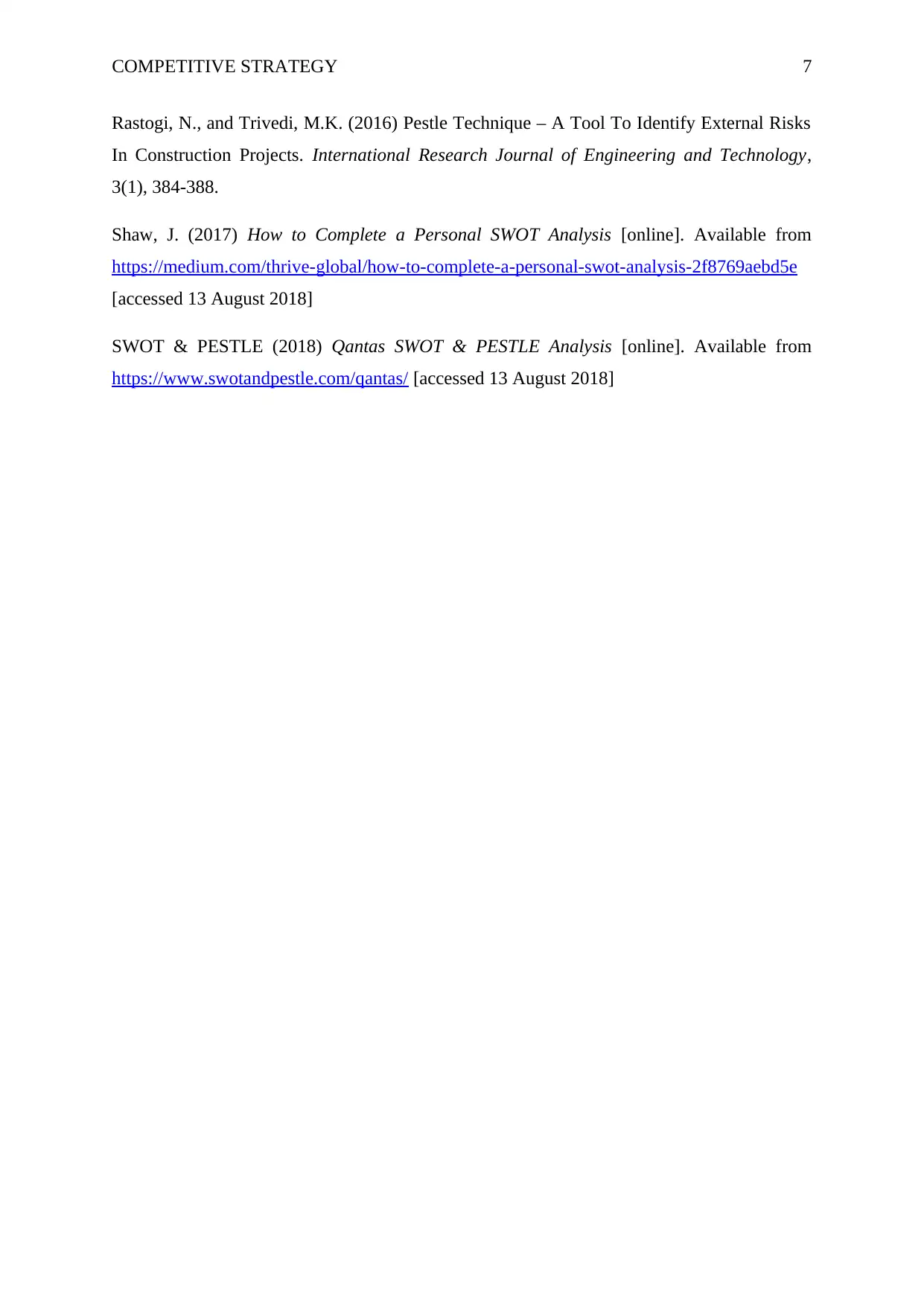
COMPETITIVE STRATEGY 7
Rastogi, N., and Trivedi, M.K. (2016) Pestle Technique – A Tool To Identify External Risks
In Construction Projects. International Research Journal of Engineering and Technology,
3(1), 384-388.
Shaw, J. (2017) How to Complete a Personal SWOT Analysis [online]. Available from
https://medium.com/thrive-global/how-to-complete-a-personal-swot-analysis-2f8769aebd5e
[accessed 13 August 2018]
SWOT & PESTLE (2018) Qantas SWOT & PESTLE Analysis [online]. Available from
https://www.swotandpestle.com/qantas/ [accessed 13 August 2018]
Rastogi, N., and Trivedi, M.K. (2016) Pestle Technique – A Tool To Identify External Risks
In Construction Projects. International Research Journal of Engineering and Technology,
3(1), 384-388.
Shaw, J. (2017) How to Complete a Personal SWOT Analysis [online]. Available from
https://medium.com/thrive-global/how-to-complete-a-personal-swot-analysis-2f8769aebd5e
[accessed 13 August 2018]
SWOT & PESTLE (2018) Qantas SWOT & PESTLE Analysis [online]. Available from
https://www.swotandpestle.com/qantas/ [accessed 13 August 2018]
1 out of 8
Related Documents
Your All-in-One AI-Powered Toolkit for Academic Success.
+13062052269
info@desklib.com
Available 24*7 on WhatsApp / Email
![[object Object]](/_next/static/media/star-bottom.7253800d.svg)
Unlock your academic potential
Copyright © 2020–2025 A2Z Services. All Rights Reserved. Developed and managed by ZUCOL.




